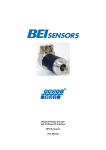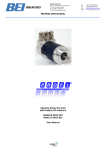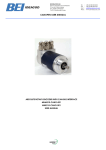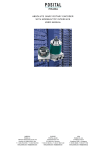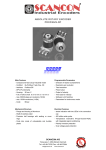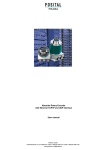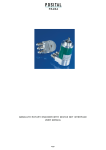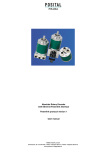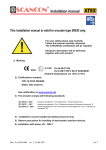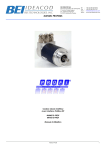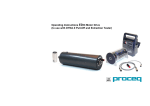Download Manual OCD Profibus English
Transcript
User Manual ® PROCESS FIELD BUS Absolute Rotary Encoder with Profibus-DP-Interface SAG-DPB1B-XXXX-XXXX-0CC User Manual Revision 01/07 Info SAG-DPB1B Page 1 1 General ......................................................... 4 1.1 Absolute Rotary Encoder.............................. 4 1.2 Profibus technology...................................... 4 2 Installation .................................................... 5 2.1 Settings in the connection cap ...................... 5 2.1.1 Station address ...................................... 5 2.1.2 Bus termination ...................................... 5 2.2 Connecting bus lines and power supply ........ 6 2.3 Connecting-up the connection cap ................ 6 2.4 Connecting the screen ................................. 7 2.5 Instructions for mechanical installation and 5.1.5 Shorter Diagnostics ..............................19 5.1.6 Software-limit switch.............................19 5.1.7 Physical impulses.................................20 5.1.8 Encoder type........................................21 5.1.9 Velocity time base ................................21 5.2 Data exchange in normal operation.............22 5.3 Commissioning mode .................................23 5.3.1 Setting the counting direction ................23 5.3.2 Teach-In Start ......................................24 5.3.3 Teach-In Stop ......................................24 5.3.4 Preset value .........................................25 6 Diagnostic messages .................................26 6.1 Overview ...................................................26 electrical connection of the angular encoder ....... 7 6.2 Supported diagnostic messages .................27 3 Device Configuration.................................... 8 3.1 Overview – Configuration principle................ 8 3.2 Overview encoder configurations functionality ....................................................... 9 3.3 Encoder configurations - data format .......... 10 4 Class 1 and Class 2 profile ......................... 11 4.1 Parameter settings ..................................... 11 4.1.1 Code sequence.................................... 12 4.1.2 Class 2 functionality ............................. 12 4.1.3 Commissioning diagnostics .................. 12 4.1.4 Scaling function ................................... 12 4.1.5 Measuring units per revolution .............. 12 4.1.6 Total measuring range ......................... 13 4.2 Data exchange in normal operation ............ 14 6.2.1 Extended diagnostics header ................27 6.2.2 Memory error .......................................27 6.2.3 Operating status...................................27 6.2.4 Encoder type........................................27 6.2.5 Singleturn resolution.............................27 6.2.6 Number of revolutions ..........................27 6.2.7 Operating time warning ........................27 6.2.8 Profile version ......................................27 6.2.9 Software version ..................................27 6.2.10 Operating time ...................................27 6.2.11 Zero offset .........................................28 6.2.12 Programmed resolution ......................28 6.2.13 Programmed total resolution ...............28 6.2.14 Serial number.....................................28 6.3 Status indication by the LEDs in the connection cap ................................................29 4.2.1 Transferring the process value ............. 14 4.2.2 Preset function ..................................... 14 7 Configuring with STEP 7 ............................30 5 Special versions SCANCON 2.1 and 2.2..... 16 7.1 Installing the GSD file .................................30 5.1 Parameter.................................................. 17 7.2 Configuring the encoder .............................32 5.1.1 Activate manufacturer-specific parameters ................................................... 17 5.1.2 Desired measuring units ....................... 17 7.3 Selecting the encoder version .....................33 5.1.3 Desired Measuring units reference ....... 18 5.1.4 Activate commissioning mode .............. 19 8 Technical Data ............................................36 Page 2 7.4 Setting the parameters ...............................34 8.1 Electrical Data ............................................36 Info SAG-DPB1B Revision 01/07 8.2 Mechanical Data ........................................ 37 9.2.2 Version SCANCON 1.1 Multiturn ..........42 9.2.3 Version SCANCON 1.0 Multiturn ..........42 9.2.4 Class 2 Multiturn ‚DX-Version’ ..............42 8.3 Environmental Conditions........................... 37 8.4 Dimensioned Drawings .............................. 38 9.3 FAQ absolute encoder Profibus ..................43 9 Appendix .................................................... 40 9.4 Definitions ..................................................44 9.1 Type designation / ordering code ................ 40 9.2 Further encoder configurations ................... 42 10 Index ...........................................................46 9.2.1 Version SCANCON 2.0 Multiturn .......... 42 Imprint SCANCON A/S Tranevang 1 DK-3450 Denmark Telephone Fax +45 48172702 +45 48172284 Internet E-mail www.scancon.dk [email protected] this documentation without written approval by the company SCANCON A/S. Specifications are subject to change without notice Technical specifications, which are described in this manual, are subject to change due to our permanent strive to improve our products. Copyright The company SCANCON A/S claims copyright on this documentation. It is not allowed to modify, to extend, to hand over to a third party and/or to copy Revision 01/07 Publication: Version: Order Number: Author: Info SAG-DPB1B Jan. 2007 4.04 99998110 Jonas Hahne Page 3 1 General This manual describes installation and configuration of the Absolute Rotary Encoder with Profibus DP interface. The device meets the requirements of a Profibus Slave according to the PROFIBUS standard. It is certified by the “Profibus Nutzerorganisation” in Germany. 1.1 Absolute Rotary Encoder Basic principle of the absolute measurement is the optical scanning of a transparent disk with code print. The code disk is connected to the shaft that is to be measured. By evaluating the code and two additional incremental signals the absolute position of the shaft can be determined with a resolution of up to 65536 steps per revolution (16 bits). So-called Multiturn-devices use reduction gears and further code disks to determine the absolute shaft position over up to 16384 revolutions (14 bits). The position value is calculated in an integrated microprocessor and transmitted over the Profibus. Further information about the basic function principle of Absolute Rotary Encoders and Profibus networks can be found on our homepage under www.scancon.dk 1.2 Profibus technology PROFIBUS is an international, open, nonproprietary fieldbus standard which is defined in the international standards EN 50170 and EN 50254. There are three different versions: Profibus DP, Profibus-FMS and Profibus-PA. SCANCON absolute encoders are designed for the DP version. They support all usual baud rates up to 12 MBaud. Besides manufacturer-specific functions, the devices support the classes 1 and 2 according to the Profile for Absolute Encoders (this device profile can be ordered under part number 3.062 from the “Profibus Nutzeroganisation”). Further information about profibus (functionality, manufacturer, products), standards and device profiles are available from the PNO: Page 4 Profibus Nutzerorganisation (PNO) Haid-und-Neu-Straße 7 D-76131 Karlsruhe Tel.: ++49 (0) 721 / 96 58 590 Fax: ++49 (0) 721 / 96 58 589 www.profibus.com Info SAG-DPB1B Revision 01/07 2 Installation The Absolute Encoder is connected with a connection cap. This cap is connected to the encoder with a 15-pin-D-Sub connector and can be removed by loosening two screws on the backside of the encoder. Bus lines and power supply are led into the cap via cable glands and connected to terminal blocks. 2.1 Settings in the connection cap 2.1.1 Station address 2.1.2 Bus termination The station (node) address is set by using the rotary switches in the cap. The values (x 10 or x 1) for the switches are marked at the switch. Possible addresses are between 0 and 99. Each address can only be used once in the network. The station address is read in when switching on the power supply. An address change by the Master (“Set_Slave_Add“) is not supported. If the encoder is connected at the end or beginning of the bus line the termination resistor must be switched on (slide switch in position “ON”). ON A + B A 901 ON device X last device 78 + The bus is only correctly terminated when the encoder is connected to the connection cap. If the encoder must be changed during operation, a separate active bus termination should be used. 23 23 78 901 456 456 Revision 01/07 ON Note The outgoing bus line is disconnected if the resistor is switched on! R B R R x10 x1 Info SAG-DPB1B Page 5 2.2 Connecting bus lines and power supply B A + B A + R ON Clamp Description B (left) Bus line B (Bus in) A (left) Bus line A (Bus in) - 0V + 10 – 30 V B (right) Bus line B (Bus out) A (right) Bus line A (Bus out) - 0V + 10 – 30 V B A + B A + The power supply has to be connected once (no matter which clamps). If the terminating resistor is switched on, the outgoing bus lines are disconnected. 2.3 Connecting-up the connection cap Remove screw, sealing and cone from the cable gland. Remove 55 mm of the cable sheath and 50 mm of the shielding. About 5 mm of the wires should be stripped. Put screw and sealing on the cable. The cone should be mounted under the shielding according to the figure. Put the whole cable into the cable gland and tighten the screw. Note: If a combined cable (power supply and bus lines in one cable) is used the large cable diameter can lead to problems. For these cases SCANCON offers connection caps with larger cable glands (refer to product catalogue). 55 mm 50 mm 5 mm Page 6 5 mm Info SAG-DPB1B Revision 01/07 2.4 Connecting the screen To achieve the highest possible noise immunity shielded cables should be used for data a compensation current might flow over the shield. Therefore a potential compensation cable is transmission. The shield should be connected to ground on both ends of the cable. In certain cases, recommended. 2.5 Instructions for mechanical installation and electrical connection of the angular encoder The following points should be observed: Do not drop the angular encoder or subject it to excessive vibration. The encoder is a precision device. Do not open the angular encoder housing (this does not mean that you cannot remove the connection cap). If the device is opened and closed again, it can be damaged and dirt may enter the unit. It is not permissible to make any electrical changes to the encoder. Route the connecting cable to the angular encoder at a considerable distance or completely separated from power cables with their associated noise. Completely shielded cables must be used for reliable data transfer and good grounding must be provided. Cabling, establishing and interrupting electrical connections may only be carried-out when the equipment is in a no-voltage condition. Short-circuits, voltage spikes etc. can result in erroneous functions and uncontrolled statuses which can even include severe personnel injury and material damage. Before powering-up the system, check all of the electrical connections. Connections, which are not correct, can cause the system to function incorrectly. Fault connections can Although SCANCON absolute encoders are rugged, when used in tough ambient conditions, they should be protected against damage using suitable protective measures. The encoder should not be used as handles or steps. The angular encoder shaft must be connected to the shaft to be measured through a suitable coupling (full shaft version). This coupling is used to dampen vibrations and imbalance on the encoder shaft and to avoid inadmissible high forces. Suitable couplings are available from SCANCON. personnel who are authorized to commission, ground and tag devices, systems and circuits according to the current state of safety technology. Only qualified personnel may commission and operate these devices. These are Revision 01/07 Info SAG-DPB1B result in severe personnel injury and material damage. Page 7 3 Device Configuration The Absolute Encoder with Profibus-Interface can be programmed according to the needs of the user. The GSD-file has to be installed in the used software tool. The user has the possibility to choose different encoder configurations. These data are stored in the profibus master. They are transmitted to the slave (encoder) when the profibus network is starting up („DDLM_Set_Prm“). It is not possible to change parameters or configuration during the normal operation of the Parameters and functionality depend on the selected encoder configuration. SCANCONAbsolute Encoders Type „SAG-DPB1B-XXXXXXXX-0CC“ support all configurations described in device (exception: “Commissioning Mode”, see chapter 5.3). After receiving configuration and parameter data the absolute encoder enters the normal operating the following, i.e. there is no functionality limitation due to the hardware. Additionally to the configurations „Class 1“ and „Class 2” (according to the Profile for Encoders) the SCANCON Encoder offers configurations with manufacturerspecific functions. By choosing a certain encoder configuration parameter and configuration data are determined. mode (cyclic data transmission – „DDLM_Data_Exchange“). In this mode the process values (e.g. the position value) are transmitted. Data length and format are determined by the user when selecting a certain encoder configuration. 3.1 Overview – Configuration principle GSD-File Software Tool database Parameter („DDLM_Set_Prm“) Once at Start-Up Choice of encoder configuration Parameter settings Page 8 PLC Cyclic Data Transmission (e.g. position value) Info SAG-DPB1B Revision 01/07 3.2 Overview encoder configurations - functionality Designation Cyclic communication Programmable parameters Additional functions Class 1 Singleturn Position value –16 bit Input Code sequence - Class 1 Multiturn Position value - 32 bit Input Code sequence - Class 2 Position value –16 bit Input Code sequence Preset function Singleturn Preset value – 16 bit Output Scaling factor Class 2 Multiturn Position value - - 32 bit Input Preset value – 32 bit Output Code sequence Scaling factor Preset function SCANCON 2.1 Singleturn Position value (32 bit Input) Preset value / Teach-In (32 bit Output) Code sequence Scaling factor Shorter Diagnostics Limit switches Preset function Commissioning mode SCANCON 2.1 Multiturn Position value (32 bit Input) Preset value / Teach-In (32 bit Output) Code sequence Scaling factor Shorter Diagnostics Limit switches Preset function Commissioning mode SCANCON 2.2 Singleturn Position value (32 bit Input) - Code sequence Scaling factor Preset function Commissioning mode Shorter Diagnostics Limit switches Velocity time base Velocity Output Code sequence Scaling factor Shorter Diagnostics Limit switches Velocity time base Preset function Commissioning mode Velocity Output - Preset value / Teach-In (32 bit Output) - Velocity (16 bit Input) SCANCON 2.2 Multiturn Position value (32 bit Input) - Preset value / Teach-In (32 bit Output) - Velocity (16 bit Input) Revision 01/07 Info SAG-DPB1B Page 9 3.3 Encoder configurations - data format Designation Configuration Input words (Encoder -> Master) Output words (Master -> Encoder) Hex Dec. Class 1 Singleturn (According to Profile) D0 208 1 0 Class 1 Multiturn (According to Profile) D1 209 2 0 Class 2 Singleturn (According to Profile) F0 240 1 1 Class 2 Multiturn (According to Profile) F1 241 2 2 SCANCON Singleturn 2.1 F1 241 2 2 SCANCON Multiturn 2.1 F1 241 2 2 SCANCON Singleturn 2.2 F1 D0 241 208 2 1 2 SCANCON Multiturn 2.2 F1 D0 241 208 2 1 2 Description Chapter Page 4 11 5 16 The following encoder configurations are still supported for reasons of downward compatibility, but should not be used for new projects (description: see Appendix): Class 2 Multiturn „DX-Version“ F1 241 2 2 9.2.4 42 SCANCON Multiturn 1.0 D3 211 4 0 9.2.3 42 SCANCON Multiturn 1.1 D3 E1 211 225 4 0 0 2 9.2.2 42 SCANCON 2.0 F1 241 2 2 9.2.1 42 D0 208 1 Multiturn Page 10 Info SAG-DPB1B Revision 01/07 4 Class 1 and Class 2 profile The encoder versions Class 1 and Class 2 are defined by the working group encoder in the „Profibus Nutzerorganisation“ in the “Profile for Encoders” (available from the PNO, Order No. 3.062). 4.1 Parameter settings The following table contains an overview of the parameters according to the Profile for Encoders and the structure of the parameter telegram. (Usually it is not necessary for the user to know the details of the structure – the parameters are set in user-friendly forms in the operator software tool.) Octet (= byte) No. Parameter 1 ... 8 Profibus Standard Parameters Bit Nr. 9 Code sequence 0 Details Class 2 functionality 1 Section 4.1.2, Page 12 Commissioning Diagnostics 2 Section 4.1.3, Page 12 Scaling function 3 Section 4.1.4, Page 12 Reserved 4 Reserved 5 Not used for Class 1 and Class 2 6 7 10 Measuring units per revolution Section 4.1.5, Page 12 Total measuring range Section 4.1.6, Page 13 ... 13 14 ... 17 18 Reserved (Profile) ... 25 26 Not used for Class 1 and Class 2 ... (Refer to versions SCANCON 2.1 und 2.2) Revision 01/07 Info SAG-DPB1B Page 11 4.1.1 Code sequence The parameter „code sequence“ defines the counting direction of the position value. The code or counter-clockwise (CCW) (view onto the shaft). The code sequence is defined in bit 0 of octet 9: increases when the shaft is rotating clockwise (CW) Octet 9 Bit 0 Direction of rotation when viewing the shaft Code 0 Clockwise (CW) Increasing 1 Counter-clockwise (CCW) In Class 1 this is the only parameter that can be set. Increasing 4.1.2 Class 2 functionality Using this switch Class 2 encoders can be restricted to the functionality of Class 1, i.e. the scaling parameters are disabled. To use the class 2 functionalities bit 1 in octet 9 has to be set. Octet 9 Bit 1 Class 2 functionality 0 Switched off 1 Switched on 4.1.3 Commissioning diagnostics This function has SCANCON encoder. no significance for the 4.1.4 Scaling function The parameter „scaling function“ enables the scaling parameters „resolution per revolution“ and „total resolution“. This switch should always be activated if functions of class 2 (or even higher classes SCANCON 2.1 and SCANCON 2.2) are to be used. Octet 9 Bit 3 Scaling function 0 Switched off 1 Switched on 4.1.5 Measuring units per revolution The parameter „measuring units per revolution“ is error (LED) and it will not enter the data exchange used to program a desired number of steps over one revolution. If the value exceeds the basic (physical) resolution of the encoder, the output code is no longer in single steps. Starting with mode. With high resolution encoders it may be necessary to divide the value into high and low word (depending on the software tool), refer to page 35. generation “B1” the encoder indicates a parameter Octet 10 11 12 Bit 31 - 24 23 - 16 15 - 8 Data 31 2 to 2 24 23 16 2 to 2 15 2 to 2 13 7–0 8 7 0 2 to 2 Desired measuring units per revolution Page 12 Info SAG-DPB1B Revision 01/07 4.1.6 Total measuring range Octet 14 Bit 31 – 24 Data 2 to 2 31 15 24 16 23 – 16 23 2 to 2 17 15 - 8 16 15 7-0 8 2 to 2 7 0 2 to 2 Programmed total measuring range in steps The parameter „total measuring range“ is used to adapt the measuring range of the encoder to the real measuring range of the application. The encoder counts up until the position value has reached the programmed total resolution and starts with 0 again. Example: 100 steps are programmed for each revolution (parameter „measuring units per revolution“) and the total resolution is set to 12800. Then the encoder counts up to 11799, starts with “0” again after 128 revolutions, counts up to 11799, and so on. Note: With many software tools it is necessary to divide the value into high and low word, refer to page 35. When choosing the total resolution the following rule has to be observed: If “steps per revolution” are set to “n” the parameter total resolution must not cause periods longer than the maximum (physical) number of revolutions (see type label), i.e. that the programmed total resolution of a 4096 revolution multiturn encoder must be less than 4096 x the programmed number of steps per revolution (the programmed total resolution of a 16384 revolution multiturn encoder must be less than 16384 x the programmed number of steps per revolution): Total resolution < measuring units per revolution x real number of revolutions (physical) If this rule is disregarded the encoder will indicate a parameter error and it will not enter the data exchange mode. With older versions a further rule had to be observed (see below). If this rule was ignored, problems occurred when using the device in endless operation (when crossing the physical zero point). With new devices (software version Note: The internal software routine only works if the encoder is in operation. If it is necessary to turn the encoder shaft more than 1024 revolutions without power supply this can lead to problems (the internal routine will not work without power supply). In this 3 Generation A1 or higher) this problem is solved by an internal software routine. For that reason the 2nd rule can be ignored if a new device is used. case the following rule should be observed even with new devices: The period, i.e. “Total resolution” / “measuring units” per revolution must be an integer and it must fit an integer number of times (integer multiple) into 4096. So the following equation must apply: (4096 x measuring units per revolution) / Total resolution = integer Revision 01/07 Info SAG-DPB1B Page 13 For multiturn devices with 16384 revolution the rule is as follows (if it is necessary to turn the encoder shaft more than 4096 revolutions without power supply): The period, i.e. “Total resolution” / “measuring units” per revolution must be an integer and it must fit an integer number of times (integer multiple) into 16384. So the following equation must apply: (16384 x measuring units per revolution) / Total resolution = integer 4.2 Data exchange in normal operation The „DDLM_Data_Exchange mode“ is the normal operation mode of the device. On request the encoder transfers the current (position) value to the master. The encoder can also receive data from the master (e.g. the preset value in the class 2 configuration). 4.2.1 Transferring the process value The multiturn encoder transmits the current position value as a 32-bit-value (double word) to the master. Word Word 1 Word 0 Function Bit Process value 31 30 29 28 27 26 25 24 23 22 21 20 19 18 17 16 15 14 13 12 11 10 9 8 7 6 5 4 3 2 1 0 0 0 X X X X X X X X X X X X X X X X X X X X X X X X X X X X X X The singleturn encoder uses a 16-bit-value (word) for data transmission. 4.2.2 Preset function Using the preset function encoder zero point to application. When using encoder position value is it is possible to adapt he the zero point of the this function the current set to the desired preset receiving the scaling parameters the preset value refers to the scaled position value. value. The integrated microcontroller calculates the internal zero point shift. It is stored non-volatile in an EEPROM (takes less than 40 ms). The preset value is activated if bit 31 in the (peripheral) output double word is set to 1 (rising edge). As the preset function is used after Page 14 Info SAG-DPB1B Revision 01/07 Data bits Bit 31 30 29 28 27 26 25 24 23 22 21 20 19 18 17 16 15 14 Master → SAG 1 0 Transfer of the required position value (= preset value) SAG → Master 0 0 New = required position value is transferred Master → SAG 0 0 Reset bit 31 – normal mode SAG → Master 0 0 New = required position value is transferred 13 12 11 10 9 8 7 6 5 4 3 2 1 0 If high precision is required the preset function preset procedure, this can result in offsets should only be executed if the encoder shaft is not moving. If the shaft moves quickly during the (because of bus delay times). Note for Singleturn devices The procedure is similar with the singleturn-version: Here Bit 15 is used to activate the preset value. With high resolution singleturn encoders (16 Bit) it is not possible to set preset values > 32767 (15 bit), as the MSB is used to activate the preset. If this Revision 01/07 functionality is needed the user has to choose one of the manufacturer specific SCANCON-encoder versions (in these classes the singleturn position is transmitted as 32-bit-value). Info SAG-DPB1B Page 15 5 Special versions SCANCON 2.1 and 2.2 The manufacturer-specific encoder configurations SCANCON 2.1 and SCANCON 2.2 offer (in addition to the functions according to the Profile for Encoders) features such as commissioning mode, velocity output and software limit switches. The following table gives an overview of the used parameters and the structure of the parameter telegram. Usually it is not necessary to know these details as the parameters are set with user-friendly software tools. Octet (byte) Parameter No. Bit Details No. Section Page 1 .. 8 Profibus Standard Parameters 9 Code sequence 0 4.1.1 12 Class 2 functionality 1 4.1.2 12 Commissioning Diagnostics 2 4.1.3 12 Scaling function 3 4.1.4 12 Reserved 4 Reserved 5 Activate manufacturer-specific parameters (octet 26) 6 5.1.1 17 Reserved 7 10 .. 13 Desired measuring units (refer to: octet 26 bit 0 and 1) 5.1.2 17 14 .. 17 Total measuring range 4.1.6 13 18 .. 25 Reserved 26 Reference for the desired measuring steps 5.1.3 18 0 1 Activate commissioning mode 2 5.1.4 19 Shorter Diagnostics 3 5.1.5 19 Reserved 4 Activate lower limit-switch 5 5.1.6 19 Activate upper limit-switch 6 5.1.6 19 Activate octets 27-39 7 5.1.1 17 27 .. 30 Lower limit switch 5.1.6 19 31 .. 34 Upper limit switch 5.1.6 19 35 .. 38 Physical impulses 5.1.7 20 39 Reserved 0 Encoder type (Single-/Multiturn) 1 5.1.8 21 Reserved 2 Reserved 3 Time base velocity 4 5.1.9 21 5 Page 16 Reserved 6 Reserved 7 Info SAG-DPB1B Revision 01/07 5.1 Parameter In the following the manufacturer specific parameters are described in detail. The parameters according to the Profile for Encoders are supported too, description: see chapter 4. 5.1.1 Activate manufacturer-specific parameters The manufacturer-specific parameter byte 26 is activated with bit 6 in octet 9. Bit 7 in octet 26 activates further parameter bytes (27-39). Usually this happens automatically if the encoder versions SCANCON 2.1 or SCANCON 2.2 are selected. It is only important for the user to observe this if the parameters are entered “manually” (directly using hex-code). Octet 9 Bit 6 Octet 26 0 Deactivated 1 Activated Octet 26 Bit 7 Octet 27 – 39 0 Deactivated 1 Activated 5.1.2 Desired measuring units The parameter „desired measuring units“ is used to program any required number of steps over 1 Octet 10 Bit 31 - 24 Data 31 2 to 2 11 12 23 - 16 24 23 revolution, over the whole measuring range or over a part of the measuring range. 13 7–0 15 - 8 16 15 2 to 2 2 to 2 8 27 to 20 Desired measuring units The reference for the desired measuring units is specified with the parameter „Desired measuring units reference“ (cp. 5.1.3). If “per revolution” is selected the measuring range can be adapted with Note: With many software tools it is necessary to divide the value into high and low word, refer to page 35. the parameter “total measuring range”. Please observe the rules in section 4.1.6. Revision 01/07 Info SAG-DPB1B Page 17 5.1.3 Desired Measuring units reference With this parameter the reference for the desired measuring units (cp. 5.1.2) is determined, either - per revolution per maximum total resolution per number of physical impulses Desired measuring units per revolution In this case the position value increases by the programmed number of steps (desired measuring units) over one revolution. Additionally the parameter “total resolution” is used to achieve an adaptation of the measuring range (cp. 4.1.6). Desired measuring units per maximum total measuring range The parameter „desired measuring units“ refers to the complete measuring range of the encoder, i.e. the encoder gives out the programmed number of measuring units over the whole measuring range (4096 revolutions with the multiturn encoder). Desired measuring units per physical impulses The desired measuring units refer to the physical impulses entered in octets 35-39 (cp.5.1.7). Physical impulses means: The real value that is read internally from the code disc (e.g. 4096 steps per revolution with a standard 12-bit-encoder). With that option it is possible to set gearing factors freely. Reference Octet 26 Bit 0 Octet 26 Bit 1 Per revolution 0 0 Per maximum total measuring range 1 0 Per physical impulses (= steps specified in octets 35-38) 0 1 Page 18 Info SAG-DPB1B Revision 01/07 5.1.4 Activate commissioning mode Bit 2 in octet 26 activates the commissioning mode. This is a special mode with the option to set further The commissioning mode can be used durably, but it is recommended to transfer the parameters parameters in the data-exchange –mode (additional to the preset value). In the commissioning mode a „Teach-In“ can be carried out, i.e. the gearing factor can be determined determined with the Teach-In into the system configuration. Then the encoder should be used in “normal” operation mode – so it is possible to exchange the device without a new Teach-In. directly in the machine. In this special mode (indicated by the flashing green LED) the parameters set in the system configuration are ignored by the encoder. It uses parameters stored in an internal EEPROM instead. A detailed description of the commissioning mode can be found in section 5.3. Octet 26 Bit 2 Commissioning mode 0 Switched off 1 Switched on Octet 26 Bit 3 Diagnostics 0 Standard = 57 bytes 1 Reduced = 16 bytes 5.1.5 Shorter Diagnostics Some Profibus masters, especially older ones, have problems with the full diagnostic data length (57 bytes). The SCANCON encoder offers the option to reduce the diagnostic data length to 16 bytes. If Class 1 is used the standard diagnostic data length is 16 bytes. 5.1.6 Software-limit switch Two positions can be programmed. If the position must not be exceeded. The limit switches are value falls below the lower limit switch or exceeds the higher limit switch, bit 27 in the 32-Bit-processvalue is set to 1. Between these limit switches bit 27 is set to 0. The limit switches can be set to any activated with bits 5 and 6 in octet 26. Note: With many software tools it is necessary to divide the values into high and low word, refer to page 35. value, but the parameter “total measuring range” Octet 27 Bit 31 - 24 Data 31 28 29 15 – 8 23 - 16 24 2 to 2 23 2 to 2 30 16 15 7-0 8 2 to 2 7 0 2 to 2 Lower limit switch (in measuring steps, related to the scaled value) Revision 01/07 Info SAG-DPB1B Page 19 Octet 31 32 33 Bit 31 - 24 23 - 16 15 – 8 31 Data 24 23 2 to 2 2 to 2 16 15 34 7-0 8 7 2 to 2 0 2 to 2 Upper limit switch (in measuring steps, related to the scaled value) Octet 26 Bit 5 Lower limit switch 0 Deactivated 1 Activated Octet 26 Bit 6 Upper limit switch 0 Deactivated 1 Activated 5.1.7 Physical impulses Octet 35 36 37 Bit 31 - 24 23 – 16 15 – 8 Data 31 2 to 2 24 23 16 15 2 to 2 2 to 2 38 7-0 8 27 to 20 Physical impulses This parameter is evaluated if the reference for the With the reference „steps per revolution“ it is „desired measuring units“ is „physical impulses“ (cp. 5.1.3). With the „physical impulses“ it is possible to set a gearing factor freely. The user defines the output impossible to program that scaling factor (it would be necessary to set the parameter „desired measuring steps“ to 133.33; this is not possible because the parameter must be an integer value). steps („desired measuring steps”) over a part of the measuring range. This option is helpful to program scaling factors that result in a non-integer number of steps over 1 revolution. Example: Problem: The position value has to increase by 400 steps over 3 revolutions. Page 20 Solution: Choose „physical impulses“ as reference for the „desired measuring units“. Now the number of physical measuring steps over the desired measuring range is determined. For this the actual (physical) resolution of the encoder (type label) is used. For our example this would be (with a standard encoder, 12 Bit resolution): Info SAG-DPB1B Revision 01/07 4096 steps/revolution x 3 revolutions = 12288 steps Enter this value (12288) as „physical impulses“ and set the „desired measuring units“ to 400. Now the encoder increases the position value by 400 steps on a measuring range of 12288 physical steps (3 revolutions). Note: With many software tools it is necessary to divide the value into high and low word, refer to page 35. 5.1.8 Encoder type The encoder type (Singleturn or Multiturn) is specified in bit 1 octet 39. Generally this bit is set automatically if the encoder version is selected. The user only has to take care of this parameter if the parameters are set “manually” in hex-code. Octet 39 Bit 1 Type 0 Singleturn 1 Multiturn 5.1.9 Velocity time base With this parameter the user can choose the time base for the velocity output (version SCANCON 2.2). The time base is specified in bits 4 and 5 of octet 39. Revision 01/07 Info SAG-DPB1B Time base Bit 4 Bit 5 Steps / second 0 0 Steps / 100 ms 1 0 Steps / 10 ms 0 1 RPM (revolutions per minute) 1 1 Page 21 5.2 Data exchange in normal operation With the manufacturer-specific versions SCANCON 2.1 and SCANCON 2.2 the process digits will be overwritten by the status bits. If the SCANCON versions are used with encoders with a value generally is transmitted as 32-bit-value (peripheral double word). Apart from 25 bits used for the position value the 7 other bits are used as status bits. The output double word contains the total (physical) resolution > 25 Bit, the user has to assure that the position value is scaled to a maximum output value < 33554432. If position values > 25 Bit are necessary class 2 should be preset value and control bits. Absolute encoders model series “SAG” might have (physical) position values > 25 Bit. The manufacturer specific SCANCON versions do not support the position values > 25 Bit. The upper used. If version SCANCON 2.2 is used the current velocity is transmitted in an additional (peripheral) input word. ID F1 hex D0 hex SAG → Master Status + position value Status + 224 Master → SAG 223 - 216 Velocity 215 - 28 27 - 20 215 - 28 27 - 20 Preset value + control bits Control + 2 24 23 16 2 -2 15 8 2 -2 7 0 2 -2 Meaning of the different status bits: Bit 28 Bit 27 Bit 26 Bit 25 Meaning Ready 0 = encoder is not ready for operation 1 = encoder is ready for operation Mode 0 = commissioning mode 1 = normal mode Software limit switch 0 = lower limit switch ≤ current position value ≤ upper limit switch 1 = current position value > upper limit switch or current position value < lower limit switch Code sequence 0 = increasing clockwise (view onto the shaft) 1 = increasing counter clockwise (view onto the shaft) Page 22 Info SAG-DPB1B Revision 01/07 5.3 Commissioning mode If the commissioning mode is activated in the encoder parameters, the scaling factor can be - The commissioning mode (parameter settings, cp. 5.1.4) determined directly in the machine by a „Teach-In“. The commissioning mode is indicated by the flashing green LED and bit 26 in the input double word (bit 26 set to 0). - The counting direction is changed (if necessary). Machine / system is to be moved to the start position. If the encoder starts up in commissioning mode the parameters in the system configuration (code sequence, scaling) are ignored. Parameters stored in an internal EEPROM are used instead. If code sequence or scaling factor are modified in commissioning mode, the new values will be stored non-volatile and the encoder works with this new parameters. The proceeding in commissioning mode is as follows: The encoder is installed in the machine / system. - - - - - is activated The Teach-In-Start command is transmitted to the encoder. Machine / system is to be moved to the stop position. With the Teach-In-Stop command the desired number of steps is transferred to the encoder. Set the preset value. The parameters in the system configuration are set to the values determined with the Teach-In procedure. Commissioning mode is deactivated (parameter settings). 5.3.1 Setting the counting direction If the encoder is operating in commissioning mode, the counting direction (code sequence) can be changed online. The current code sequence is indicated with bit 28 in the 32-bit-process value (0: Status bits Bit 31 30 29 28 increasing clockwise / 1: increasing counter clockwise). With bit 28 in the output double word the counting direction can be changed. Data bits 27 26 25 24 23 22 21 20 19 18 17 16 15 14 13 12 11 10 9 8 7 6 5 4 3 2 1 Master → SAG 0 0 0 1 SAG → Master 0 0 0 0/1 0 0 1 Encoder sends acknowledgement (new counting direction) in bits 0 and 28 Master → SAG 0 0 0 0 SAG → Master 0 0 0 0/1 X 0 1 Output process value with changed counting direction 0 0 0 0 Changing the counting direction by setting bit 28 0/1 0 0 0 Changeover is completed by reset bit 28 The counting direction is stored non-volatile in an internal EEPROM. Revision 01/07 Info SAG-DPB1B Page 23 5.3.2 Teach-In Start After the machine / system has been moved to the start-position the Teach-In-Start command is Status bits transmitted to the encoder. The device now starts the internal calculation of a new scaling factor. Data bits Bit 31 30 29 28 27 26 25 24 Master → SAG 0 1 0 0 0 0 0 Start the Teach-In by setting bit 30 to 1 SAG → Master 0 1 0 X X 0 1 Acknowledgement of the encoder by setting bit 30 to 1 Master → SAG 0 0 0 0 0 0 Reset bit 30 SAG → Master 0 1 0 X X 0 1 Non-calculated position value is transmitted (gearing factor = 1, no offset) 0 23 22 21 20 19 18 17 16 15 14 13 12 11 10 9 8 7 6 5 4 3 2 1 0 Note: The scaling factor is set to 1; the zero point shift is set to zero. 5.3.3 Teach-In Stop After moving the machine / system to the stopposition the Teach-In-Stop command is send. Together with this command the desired number of steps over the moved measuring range is transmitted. The user has to observe that the physical resolution is not exceeded (e.g. 20000 steps on a quarter of a revolution). Positive and negative directions are taken into account automatically, also the crossing of the physical zero point. Note: The measuring range must not exceed the half physical measuring range of the encoder (i.e. a maximum of 2047 revolutions for a Status bits multiturn device with 4096 revolutions and a maximum of 8181 revolutions for the 14-Bitmultiturn). After receiving the Teach-In-Stop command the encoder transmits the calculated total resolution. This value should be noted and later (when switching the device to normal mode) entered into the parameter settings. After this Teach-In procedure the encoder operates with the new gearing factor (which is stored nonvolatile in the internal EEPROM). Data bits Bit 31 30 29 28 27 26 25 24 Master → SAG 0 0 1 0 0 0 0 Number of desired measuring steps (on the traversed measuring range) SAG → Master 0 1 1 X X 0 1 Transfer of the total resolution (should be noted) Master → SAG 0 0 0 0 0 0 Reset bit 29 SAG → Master 0 0 0 X X 0 1 Output of the current position value, scaled with the new gearing factor 0 23 22 21 20 19 18 17 16 15 14 13 12 11 10 9 8 7 6 5 4 3 2 1 0 In order to replace the encoder later without a new Teach-In procedure, the total measuring range determined with the Teach-In should be transferred measuring range“. When setting the parameters it should be observed that the code sequence is correct (the setting of the counting direction in into the system configuration. For this the „total resolution“ must be entered into the parameter field „desired measuring units“ (cp. 5.1.2) and the reference (cp. 5.1.3) must be set to “maximum total commissioning mode has to be transferred to the system configuration). Subsequently the commissioning mode can be switched off and the encoder can be used in normal mode. Page 24 Info SAG-DPB1B Revision 01/07 5.3.4 Preset value The preset function is similar to the procedure versions SCANCON 2.1 or SCANCON 2.2 there is described in section 4.2.2. There is only one difference: When using the manufacturer-specific an acknowledgement (bit 31 in the input double word is set to 1): Status bits Bit 31 30 29 28 Data bits 27 26 25 24 23 22 21 20 19 18 17 16 15 14 13 12 11 10 9 8 Master → SAG 1 0 0 0 0 0 0 Transfer of the required position value (= preset value) SAG → Master 1 0 0 0 0 0 1 New = required position value is transferred Master → SAG 0 0 0 0 0 0 0 Reset bit 31 – normal mode SAG → Master 0 0 0 0 0 0 1 New = required position value is transferred Revision 01/07 Info SAG-DPB1B 7 6 5 4 3 2 1 0 Page 25 6 Diagnostic messages 6.1 Overview On request of the master the encoder transmits diagnostic data ("DDLM_Slave_Diag"). The diagnostic data is according to the Profibus Standard (octets 1-6) respectively according to the diagnostic data length is 57 bytes (Exception: shorter diagnostics, cp. 5.1.5). The format of the Profile for Encoders (starting from octet 7). Diagnostic function Data type Diagnostics - octet number Class Station status 1 (ref. to: Profibus Standard) Octet 1 1 Station status 2 (ref. to: Profibus Standard) Octet 2 1 Station status 3 (ref. to: Profibus Standard) Octet 3 1 Diagnostic master address Octet 4 1 PNO identification number Octet 5, 6 1 Extended diagnostic header Octet String 7 1 Alarm messages Octet String 8 1 Operating status Octet String 9 1 Encoder type Octet String 10 1 Resolution per revolution (Hardware) Unsigned 32 11 - 14 1 Number of revolutions (Hardware) Unsigned 16 15, 16 1 Additional alarm messages Octet String 17 2 Supported alarm messages Octet String 18, 19 2 Warnings Octet String 20, 21 2 Supported warnings Octet String 22, 23 2 Profile version Octet String 24, 25 2 Software version Octet String 26, 27 2 Operating time Unsigned 32 28 - 31 2 Zero offset Unsigned 32 32 - 35 2 Manufacturer-specific: offset value Unsigned 32 36 - 39 2 Programmed resolution per revolution Unsigned 32 40 - 43 2 Programmed total resolution Unsigned 32 44 - 47 2 Serial number ASCII String 48 - 57 2 Page 26 Info SAG-DPB1B Revision 01/07 6.2 Supported diagnostic messages 6.2.5 Singleturn resolution In the following the different diagnostic messages are described in detail. Diagnostic bytes 11-14 contain the real (physical) resolution per revolution of the encoder. 6.2.1 Extended diagnostics header 6.2.6 Number of revolutions Byte 7 contains the length of the extended Diagnostic bytes 15 and 16 contain the real diagnostics (including header itself). (physical) number of revolutions of the encoder. Standard values are 1 for singeturn and 4096 (resp. 16384) for multiturn devices. 6.2.2 Memory error Bit 4 in diagnostic byte 8 is used to indicate a memory error. Memory error means that the internal EEPROM of the encoder no longer works correctly and that it cannot be guaranteed that values (e.g. offset value) are stored non-volatile. 6.2.7 Operating time warning Bit 4 in diagnostic byte 21 indicates an operating time warning. The bit is set after 105 hours. 6.2.8 Profile version Diagnostic bytes 24 and 25 contain the profile version of the encoder. Bit Definition 0 1 4 Memory error No Yes (defective EEPROM) Byte 24 Bit 15 – 8 Data 6.2.3 Operating status Diagnostic byte 9 contains certain parameters (set in the system configuration). 7 25 0 2 -2 27 - 20 Revision No. Index 6.2.9 Software version Diagnostic bytes 26 and 27 contain the software version of the encoder. Bit Definition 0 1 0 Direction of rotation CW CCW 1 Class 2 functionality Off On Octet 26 2 Diagnostic routine Off On Bit 15 – 8 3 Scaling function Off On Data 6.2.4 Encoder type Diagnostic byte 10 contains the encoder version (singleturn or multiturn). Byte 10 Definition 0 Singleturn encoder 1 Multiturn encoder Revision 01/07 7–0 7 27 7-0 0 2 to 2 27 to 20 Revision No. Index 6.2.10 Operating time The operating time of the encoder can be read out from diagnostic bytes 28 to 31. If the encoder is connected to the power supply the operating time is stored in an EEPROM every six minutes in 0.1 h steps. Info SAG-DPB1B Page 27 6.2.11 Zero offset 6.2.14 Serial number The zero offset is output in diagnostic bytes 32 to 35. Diagnostic bytes 48-57 are intended for a serial number. 6.2.12 Programmed resolution With the current version the serial number is not saved in the encoder, the bytes contain the default value 2A hex. The programmed resolution per revolution is output in diagnostic bytes 40 to 43. The value is only valid if the scaling factor is based on the parameter „resolution per revolution“ (cp. 5.1.3). 6.2.13 Programmed total resolution The programmed, respectively calculated total resolution is output in diagnostic bytes 44-47. Page 28 Info SAG-DPB1B Revision 01/07 6.3 Status indication by the LEDs in the connection cap Two LEDs are implemented in the connection cap. They optically indicate the status of the encoder in the profibus network. The red LED is used to display errors, the green one displays the status of the encoder. Both LEDs LED rot / red LED grün / green can have one of three possible conditions: dark, bright and flashing. Seven of the nine possible combinations are used to indicate a special condition. If there are any problems with starting-up the system, the state of the LEDs can give important information about the error cause. No. Red LED Green LED Status / possible cause 1 Dark Dark No power supply. 2 Bright Bright Encoder is ready for operation but it has not received any configuration data after power on. Possible causes: address setting incorrect, Bus lines not connected correctly. 3 Bright Flashing Parameter or configuration error. The encoder receives configuration or parameter data with incorrect length or inconsistent data. Possible cause: parameter value “total measuring range” too high 4 Flashing Bright The encoder is ready for operation but not addressed by the master (e.g. incorrect address in configuration). 5 Bright Dark Encoder has not received any data for a longer period (about 40 sec.). Possible cause: bus line has been interrupted. 6 Dark Bright Normal operation in data exchange mode 7 Dark Flashing Commissioning mode Revision 01/07 Info SAG-DPB1B Page 29 7 Configuring with STEP 7 In the following the configuration of the SCANCON encoder with the configuration tool STEP 7 is shown exemplarily. In this example STEP 7 Version 5.1 and the CPU 315-2DP (profibus- master integrated) are used. If there are questions about other software tools please contact the manufacturer. 7.1 Installing the GSD file If SCANCON encoders are used for the first time it Choose “Install New GSD” in the “HW Config”- is necessary to install the GSD file („SCAN4711.gsd“) to take over the encoder into the hardware catalogue of the tool: window of the project (menu item “Options”) and select the GSD-file (“SCAN4711.gsd”). The GSD file can be downloaded from our homepage www.scancon.dk. After the successful installation of the GSD file the SCANCON encoder can be found in the hardware installed. The procedure is the same as with the GSD file. catalogue under „PROFIBUS-DP“ – „Additional Field Devices“ – „Encoders“ – „SCANCON Encoder“. In order to represent the encoder with a bitmap in STEP7 the bitmap file „SAGDPxxn.bmp“ has to be Page 30 Info SAG-DPB1B Revision 01/07 Revision 01/07 Info SAG-DPB1B Page 31 7.2 Configuring the encoder After inserting the Profibus master system in the hardware configuration (“Insert” – “Master System”) the SCANCON encoder can be chosen from the hardware catalogue and added to the profibus network: Select the device “SCANCON Encoder” and drag it with the mouse to the network (or choose the network and double click the “SCANCON encoder”). Now the slave address has to be entered (has to be equal to the address setting in the connection cap). Page 32 Info SAG-DPB1B Revision 01/07 7.3 Selecting the encoder version As described in chapter 3 the functionality of the selected. For this, one of the modules listed under encoder depends on the selected encoder version. After the “SCANCON encoder” has been added to the network the desired encoder version can be SCANCON encoder has to be dragged to Slot 1 in the displayed configuration table of the encoder. Revision 01/07 Info SAG-DPB1B Page 33 7.4 Setting the parameters Select the encoder in the hardware configuration and double click slot one in the configuration table of the encoder. The dialog „Properties – DP slave“ appears. The input and output addresses can be changed (if desired). To set the encoder parameters the tab “Parameter Assignment” has to be selected. After choosing the „Device-specific parameters“ the different parameters (depend on clicking on it. Numerical values have to be entered directly. The example shows the parameters of the encoder version) can be set. If several possibilities are offered for one parameter the parameters list is opened by double encoder version SCANCON 2.2, the version with the highest functionality. Page 34 Info SAG-DPB1B Revision 01/07 Due to the software tool STEP7 32-bit parameter values (e.g. total measuring range, software limit switches) have to be divided into high and low word. Example: Decimal Hexadecimal 129600 00 01 FA 40 Hexadecimal Decimal (to be entered) High word 00 01 1 Low word FA 40 64064 The decimal value „1“ has to be entered into the high word parameter field, the value 64064 into the low word parameter field. Or: Divide the value by 65536; enter the integer part of the result into the high word parameter field, the remainder into the low word field. 129600 / 65536 = 1.977539 129600 – 1 x 65536 = 64064 → → integer part = 1 remainder = 64064 → high word = 1 → low word = 64064 It is also possible to enter the parameters directly as hexadecimal code. However this is very complicated and it should be avoided if possible. Revision 01/07 Info SAG-DPB1B Page 35 8 Technical Data 8.1 Electrical Data General design According to DIN VDE 0160 Protective Class III, degree of pollution 2, over voltage Category II Power supply voltage 10 - 30 V DC (absolute limit values) * Power drain max. 2.5 Watt Current consumption max. 230 mA with 10 V DC, max. 100 mA with 24 V DC EMC Emitted interference according to EN 61000-6-4 Noise immunity according to EN 61000-6-2 Bus connection Electrically isolated by optocouplers Interface Line driver according to RS 485 Baud rates 12 MBaud, 6 MBaud, 3 MBaud, 1.5 MBaud, 500 kBaud, 187.5 kBaud, 93.75 kBaud, 45.45 kBaud, 19.2 kBaud, 9.6 kBaud Resolution Standard: 4096 steps/revolution (optional up to 65536 steps/revolution) Number of revolutions 1 (Singleturn) 4096 or 16384 (Multiturn) Accuracy of division ½ LSB (up to 12 Bit), 2 LSB (up to 16 Bit) Step frequency max. 800 kHz Code Binary Lifetime (electrical) > 105 h Addressing Using rotary switches in the connection cap * Note The absolute angular encoder may only be operated with safety extra low voltage according to EN 50 178! Page 36 Info SAG-DPB1B Revision 01/07 8.2 Mechanical Data Housing Aluminum, optional stainless steel Lifetime Dependent on shaft version and shaft loading – refer to table Max. shaft loading Axial 40 N, radial 110 N Inertia of rotor 30 gcm Friction torque 3 Ncm (without shaft sealing) RPM (continuous operation) Singleturn: max. 12,000 RPM Multiturn: max. 6,000 RPM 2 Shock (EN 60068-2-27) 100 g (halfsine, 6 ms) Permanent shock (EN 60028-2-29) 10 g (halfsine, 16 ms) Vibration (EN 60068-2-6) 10 g (10 Hz ... 2,000 Hz) Weight (standard version) Singleturn: 550 g Multiturn: 600 g Singleturn: 1,100 g Multiturn: 1,200 g Weight (stainless steel version) Clamp (C) Hollow shaft (B) Shaft diameter Flange 6 mm 10 mm 10 mm 15 mm Shaft length 10 mm 20mm 20 mm - - - - 15 mm / 30 mm hollow shaft depth min. / max. Synchro (S) Minimum (mechanical) lifetime 8 Flange Lifetime in 10 revolutions with Fa / Fr 40 N / 60 N 40 N / 80 N 40 N / 110 N C10 (Clamp flange 10 x 20) 247 104 40 S10 (Synchro flange 10 x 20) 262 110 42 S6 (Synchro flange 6 x 10) without shaft sealing 822 347 133 S6 (Synchro flange 6 x 10) with shaft sealing: max. 20 N axial, 80 N radial 8.3 Environmental Conditions Operating temperature - 40 .. +85°C Storage temperature - 40 .. + 85 °C Humidity 98 % (without liquid state) Protection class (EN 60529) Casing side: IP 65 Shaft side: IP 64 (optional with shaft sealing: IP66) Revision 01/07 Info SAG-DPB1B Page 37 8.4 Dimensioned Drawings Synchro flange (S) available in 2 versions Synchro flange d / mm l / mm Version S06 6f6 10 Version S10 10h8 20 Single-Turn=82, Multi-Turn=92 30 3xM4x6 Ø42 Ø60 ~32 l 63,5 Ø59 (Ø61)* d ø50 f7 ø58 0° 12 3x 23 3 3 4 * Edelstahl / Stainless steel Ø6,5-9 15 20 20 Schlüsselweite, wrench size=17 Clamp flange (C) Single-Turn=82, Multi-Turn=92 30 30 3xM4x6 12 3x 3xM3x6 15° 63,5 Ø60 23 Ø4 8 Ø59 (Ø61)* 1 Ø10 h8 Ø36 f7 Ø53 Ø58 3x12 0° 0° 10 18 ~27 3 3 * Edelstahl / Stainless steel 15 Ø6,5-9 20 20 Schlüsselweite, wrench size=17 Page 38 Info SAG-DPB1B Revision 01/07 Hollow shaft (B) 72 Ø63 Single-Turn=100 , Multi-Turn=112 3,3 20 Ø60 63,5 Ø15 F7 23 20° Ø59 (Ø61)* 1,3 ~32 Anlagekante an Momentenstütze (lay-on edge torque support) Ø3,2 * Edelstahl / Stainless steel Max. W ** = 30 Min. W ** = 15 Ø6,5-9 15 20 ** Welleneinstecktiefe (hollow shaft depth) 20 Schlüsselweite, wrench size=17 Mounting instructions The clamp ring may only be tightened if the shaft of the driving element is in the hollow shaft. The diameter of the hollow shaft can be reduced to 12mm, 10 mm or 8 mm by using an adapter (this reducing adapter can be pushed into the hollow shaft). Revision 01/07 Allowed shaft movements of the drive element are listed in the table. axial radial static ± 0.3 mm ± 0.5 mm dynamic ± 0.1 mm ± 0.2 mm Info SAG-DPB1B Page 39 9 Appendix 9.1 Type designation / ordering code Description Type Key Optocode SAG- DP Interface Version Code Revolutions (Bits) Profibus DP Steps per revolution (Bits) Flange Shaft diameter Mechanical options Connection B1 B- __ __- _ __ _- 0CC B1 Binary Singleturn B 00 Multiturn (4096 revolutions) Multiturn (16384 revolutions) 4096 8192 65536 Clamp flange 12 14 12 13 16 Synchro flange Hollow shaft 10 mm 06 mm 15 mm (hollow shaft) Without Shaft sealing (IP66) Stainless steel version Customized Connection Cap Has to be ordered separately – see accessories C S B 10 06 15 0 S V C 0CC Standard = bold, further models on request Page 40 Info SAG-DPB1B Revision 01/07 Accessories and Documentation Description Connection cap Type T-coupling-functionality setting Standard with integrated address AH 58-B1DP-3PG Stainless steel configuration AH 58-B1DP-3PG-VA Connection cap “2M20” - special version - Same function as standard cap but only two cable glands for cable diameters from 9 up to 13 mm AH 58-B1DP-2M20 Shaft coupling ** Drilling: 10 mm GS 10 Drilling: 6 mm GS 06 Disc with GSD-file * Must be ordered once encoder is used for the first time DK-AWC-DP Clamp disc ** 4 pcs. / encoder SP 15 Clamp ring ** 2 pcs. / encoder SP H Reducing adapter *** 15 mm to 12 mm RR12 Reducing adapter *** 15 mm to 10 mm RR10 Reducing adapter *** 15 mm to 8 mm RR8 User manual * Installation / configuration manual for Profibus, English UME-B1DP User manual * Installation / configuration manual for Profibus, German UMD-B1DP GSD-file * * These can be downloaded free of charge from our homepage www.scancon.dk ** not for hollow shaft *** only for hollow shaft Revision 01/07 Info SAG-DPB1B Page 41 9.2 Further encoder configurations The encoder versions described in the following are still supported for reasons of downward compatibility. They should not be used in new projects! 9.2.1 Version SCANCON 2.0 Multiturn This version differs from version 2.2 in the fact that there is a smaller number of parameters shown in the configuration tool. 9.2.2 Version SCANCON 1.1 Multiturn This is an older version formerly called Class „3“. It is similar to class 2 but has an additional velocity output. It is still available for reasons of downward compatibility but it should not be used for new projects. 9.2.3 Version SCANCON 1.0 Multiturn Output of position value and velocity without preset function. Should no longer be used. 9.2.4 Class 2 Multiturn ‚DX-Version’ Old version with reduced number of diagnostic data. Should only be used with older encoders with “DX” in the type key. Page 42 Info SAG-DPB1B Revision 01/07 9.3 FAQ absolute encoder Profibus Problem Solution There are problems with the profibus network (bus error, no answer from the encoder) if one of the following profibus masters is used: If it is possible the maximum number of diagnostic data per slave should be increased in the master. If this is not possible the encoder can either be used as a „class 1“ encoder (diagnostic data length - SIEMENS S5-95U Master Interface SIEMENS IM 308-B Softing PROFIboard Allen Bradley 1785 PFB/B Mitsubishi A1SJ 71PB92D 16 bytes) or one of the manufacturer-specific versions (SCANCON 2.1 or 2.2) can be used with reduced diagnostics (cp. 5.1.5). Possible cause The masters do not support the full diagnostic data length (57 bytes). Problem If COM PROFIBUS Version 5.0 is used it is not possible to insert the SCANCON encoder into the hardware configuration if the PLC S5-95U is used. Solution Use COM PROFIBUS Version 3.3, choose one of the manufacturer-specific SCANCON-versions (SCANCON 2.1 or 2.2) and activate the reduced diagnostics. Cause The S5-95U does not support the full diagnostic data length (57 bytes). COM PROFIBUS V5.0 checks the GSD-parameter „Max_Diag_Data_Len=57“ and prevents the configuration of both devices together. If COM PROFIBUS V5.0 is to be used the configuration of the SCANCON encoder is only possible with a modified GSD file (slave key „Max_Diag_Data_Len“ has to be changed). Problem Both LEDs bright: PLC and master are switched on, bus is active, but there is no answer from the encoder. Possible solutions Encoder is ready but receives no configuration or parameter telegrams. Check the address setting in the connection cap. Check the connection of the bus lines (BUS IN / BUS OUT). Check the First of all the state of LEDs in the connection cap should be checked (cp. section 6.3). Possibly this can give hints to the cause of the problem. Both LEDs dark: Check power supply! hardware configuration in your software tool. Red LED bright, green LED flashing: Parameter error! Check parameters, e.g. the rules for setting the total measuring range (cp. 4.1.6) Revision 01/07 Info SAG-DPB1B Page 43 Problem Sporadic bus errors The resistance value must be about 110 Ω (220 Ω parallel 220 Ω). Possible cause Terminating resistors not correct Possible cause EMC problems Possible solution Check terminating resistors! The resistors of 220 Ω must be switched on at Possible solutions Is the used baud rate acceptable for the length of the bus lines? Try to use lower baud rate if the beginning and at the end of the bus segment. Switch off the power supply and measure the resistance between the terminals A and B in the connection cap. necessary. Check the connection of the cable shield in the connection cap. Are all cables and conductions laid according to EMC rules? 9.4 Definitions Address A number, which is assigned to each node, no matter whether it is a master or slave. The address is set (non-volatile) in the connection cap using rotary switches. AWC Abbreviation: Absoluter Winkelcodierer (German) = Absolute Rotary Encoder Baud rate Data transfer rate specified as the number of bits transferred per second (baud rate = bit rate). Bus Node Device, which can send, receive or amplify data via the bus. Configuring When the master configures the slave the properties of the slave are specified (e.g. number of input and output bytes). DDLM Direct Data Link Mapper. Interface between Profibus-DP functions and the encoder software. DDLM_Data_Exchange Operating status of the bus, for standard data transfer. DDLM_Set_Prm Operating status of the bus, configuration and parameter are transmitted „DDLM_Slave_Diag“ Operating status, diagnostic data are requested from the slave (e.g. encoder). Diagnostics Identification, localization, classification, display, additional evaluation of faults, errors and messages. Freeze This is a master command to the slave. This allows the master to freeze the states of the inputs (for example of the absolute angular encoder) to their current value. The input data are only updated again after reception of the UNFREEZE command. Page 44 Info SAG-DPB1B Revision 01/07 GSD file File that contains slave-specific characteristics. The GSD file is supplied by the manufacturer of the profibus slave. The GSD format is standardized (defined in GSD specifications), so configuration tools of various manufacturers can use the GSD files. Master “Active” device in the network that can send data without request. Controls the data interchange. Octet Data unit of 8 bits = 1 byte Profibus Process Fieldbus, European fieldbus standard, which is defined in the PROFIBUS Standard (EN 50170). This specifies functional, electrical and mechanical characteristics for a bit-serial fieldbus system. Slave Bus node, that only sends data on request of the master. Absolute rotary encoders are always slaves. Terminating resistor Resistor that terminates the bus cable; terminating resistors are always required at the end of a cable or segment. Type file Similar to GSD file, is used with older configuration software tools. Word Expression used for a data unit of two bytes. Revision 01/07 Info SAG-DPB1B Page 45 10 Index B L Bus termination ............................................... 5 LEDs ............................................................ 29 Low word ...................................................... 34 C Class 1 ......................................................... 11 Class 2 ......................................................... 11 Code sequence ............................................ 12 Commissioning mode.................................... 23 Configuring the encoder ................................ 31 Connecting bus lines ..................................................... 6 power supply ............................................... 6 Connection cap settings ....................................................... 5 M Mechanical Data ........................................... 36 Memory error ................................................ 27 O Operating time warning ................................. 27 Ordering code ............................................... 39 P Data format................................................... 10 Desired measuring units................................ 17 Diagnostic messages .................................... 26 Dimensioned Drawings ................................. 37 Parameter settings ........................................ 11 Parameters ................................................... 33 Physical impulses .............................. 16, 18, 20 Preset function .............................................. 14 Preset value.................................................. 25 Profibus Nutzerorganisation ............................ 4 Profile for Absolute Encoders .......................... 4 E S Electrical Data .............................................. 35 Encoder configurations.................................... 9 further ....................................................... 41 Endless operation ......................................... 13 Environmental Conditions.............................. 36 Shorter Diagnostics ....................................... 19 Software-limit switch ..................................... 19 Station address ............................................... 5 Status bits..................................................... 22 STEP 7 ......................................................... 30 F T FAQ ............................................................. 42 Teach-In Start ............................................... 24 Teach-In Stop ............................................... 24 Technical Data .............................................. 35 Total measuring range .................................. 13 Type designation........................................... 39 D G GSD file........................................................ 44 Installation................................................. 30 Type file........................................................ 44 H High word ..................................................... 34 V Velocity Time base ................................................. 21 I Installation ...................................................... 5 Page 46 Info SAG-DPB1B Revision 01/07















































